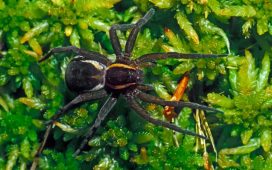Scientists have discovered a strange new toad species smaller than a fingernail in a rainforest in northeast Brazil, shedding more light on the rich diversity of life forms in the region.
The species reaches less than 1cm in length as adults and has been named Brachycephalus dacnis after the conservation NGO Project Dacnis behind the discovery.
Researchers studying similar small-sized “flea toads” found this species to be particularly interesting due to its diminutive size as one of the smallest known vertebrate animals.
“Despite being among the smallest frogs globally (the second smallest amphibian species), it exhibits skeletal traits typical of larger frogs,” scientists wrote.
“During its evolution, it underwent what we biologists call miniaturization, which involves loss, reduction and/or fusion of bones, as well as fewer digits and absence of other parts of their anatomy,” said Luís Felipe Toledo, a co-author of the study, published in the journal PeerJ.

The species is very similar in appearance to another in the area – B hermogenesi – which also has the same yellowish-brown skin, lives in leaf litter, and emerges as tiny frogs from their eggs and not as tadpoles.
However, they were alerted to the existence of this new species by its distinct calls.
Then DNA analysis confirmed that B dacnis was indeed a new species.
“In the present study, we describe a new species of Brachycephalus, one of the smallest vertebrates known,” scientists wrote.
“There may have been specimens belonging to the new species among those that served as a basis for describing B hermogenesi in 1998,” Dr Toledo said.
In the description of the new species, scientists have also included information about its skeleton, internal organs, molecular data along with details of its vocalisations.
These details are necessary to distinguish them from others more precisely as many species are cryptic and cannot be differentiated by external anatomy only.
“Our description underscores how discoveries within the megadiverse fauna of the Atlantic Forest – a rich biodiversity hotspot – can provide insights into vertebrate body size,” researchers said.
“The diversity of these miniature frogs may be far greater than we think. Hence the importance of describing as many traits and features as possible, to expedite the description process and get to work on conservation as quickly as possible,” Dr Toledo said.














